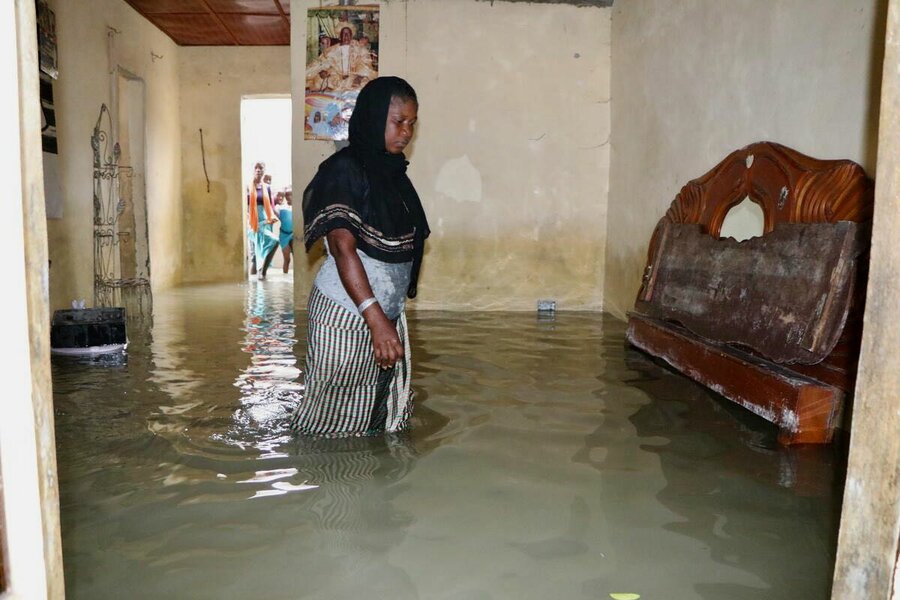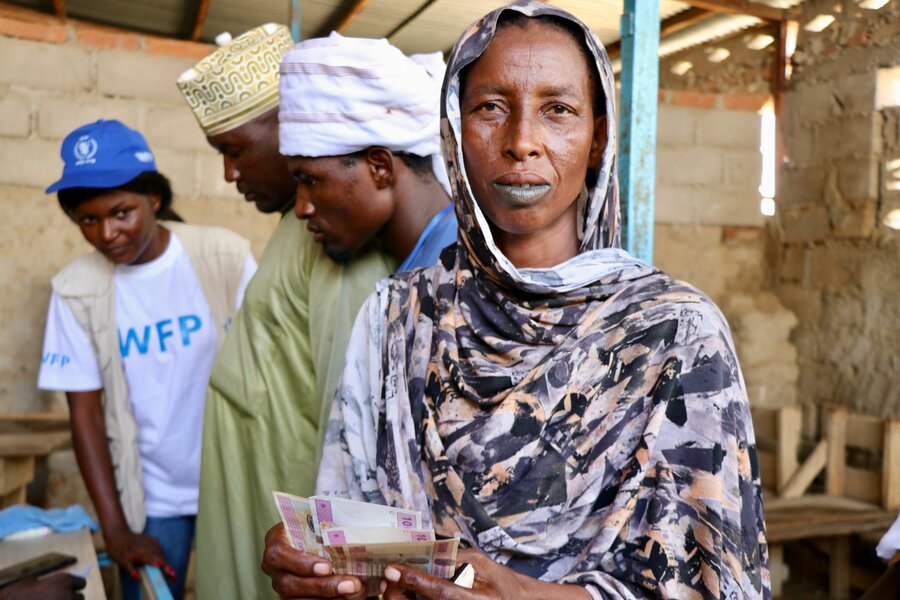THE ROAD TO COP: Deadly floods deepen food crisis in West and Central Africa amid climate crisis
This is the first of WFP's weekly series on climate change, ahead of the COP 27 summit in Sharm El-Sheikh, Egypt, from 6-18 November 2022.
Saly Sane woke up in the middle of the night to find her house flooded and her belongings floating around her compound, as torrential rains pounded Tawuto, a neighborhood south of The Gambia’s capitol Banjul.

“Every day, since heavy rains started in July, it is like this,” says Saly, one recent morning, as she desperately tries to scoop water out from her living room with a small bucket. “Everything is wet, everything is lost. It is really hard for me and my husband.”
Like thousands of Gambians, the mother of seven has lost her possessions to some of the country’s worst flooding in decades. And the deluge didn’t stop there.
Weeks of heavy rains and floods have affected 5 million people in 19 countries across West and Central Africa, killing hundreds, displacing tens of thousands and destroying many hectares of croplands. Forecasts suggest above-average rainfall will continue through October in many parts of the region.
In response, the World Food Programme (WFP) is working with national governments to support flood-hit communities. WFP’s emergency assistance, provided through food and cash distributions, keeps vulnerable families afloat amid a broader economic downturn, as the war in Ukraine – a key grain exporter – feeds skyrocketing food, fertilizer and fuel prices, and pushes basic meals beyond people's reach.

WFP is also looking longer term, rolling out programmes that allow communities and governments to better prepare and recover from future floods and other weather disasters – which will likely become ever more devastating and frequent with climate change.
“Strengthening resilience and promoting climate adaptation is more than urgent to anticipate climate hazards, restore degraded ecosystems and protect vulnerable communities against the impact of weather extremes,” says Chris Nikoi, WFP’s Regional Director for West and Central Africa.
Deepening hunger
At Saly’s home, the floodwaters destroyed beds, food stocks and clothes. Her 16-year-old daughter, Mariam, lost all her textbooks on the eve of the new school year, which started late September.
“I feel so sad as a student, I really need my past papers back,’ Mariam says. “What am I going to do without my past notes?”

The floods have intensified West and Central Africa’s worst hunger crisis in a decade. A mix of factors left 43 million people facing emergency and crisis levels of food insecurity during the lean season between June and August.
“We are suffering a lot here,” says Amboya, a widow and mother of six who lives outside of Chad’s capital Ndjamena, where heavy rains submerged parts of the city. “Our houses have collapsed and our children are starving. It is hard to get food as everything was destroyed by the floods.”
Further northwest in the Lake Chad region, farmer Mahamat Kary points to his field of maize covered by floodwaters.
“I am so sad, I don't know what to do.” he says. “The harvest is destroyed. The rain that is normally supposed to help us grow food to eat is now becoming a problem.”
Spiralling prices of food, fuel and fertilizer since the war in Ukraine are also deepening hunger and stirring up socioeconomic tensions – even as debt burdens hamper governments’ abilities to respond, a recent expert assessment found.

In Mauritania, for example, wheat is 49 percent higher than the 5-year average, while in Sierra Leone, imported rice price increased by 87 percent. In Burkina Faso, where the price of staple sorghum has risen 85 percent, protracted armed conflict adds an extra challenge.
“We need to provide a joint response – not only for people who have been displaced due to the conflict, but also the fact that just to feed themselves costs practically triple the price,” says Elvira Pruscini, WFP Country Director in Burkina Faso.
Adapting to a changing climate
WFP is also focusing on finding longer-term solutions to climate disasters. Our programmes include setting up early-warning systems, which provide information that helps authorities and communities to prepare for hazards.

They also offer funding opportunities to avert or mitigate the impact of imminent, extreme weather events.
As Niger reeled from deadly floods in August, for example, WFP worked to deliver early-warning messages and other key information to 200,000 at-risk people via radio and text messages
In arid lands across the Sahel, we focus on building local resilience to the cascading effects of climate change, through farming techniques that help restore degraded land and ecosystems. We support communities in building rainwater catchment systems and other sustainable water storage options that allow them to plant fruits and vegetables even after the riverbeds dry up.
WFP also implements a climate-insurance programme that allows African governments and communities to better respond to climate disasters.
This year, for example, WFP distributed US$9.4 million of African Union climate insurance payouts in the West African countries of Mauritania, Mali and Burkina Faso, to help communities recover from a crippling 2021 drought.

For Karim Sore, a farmer in Burkina Faso’s Centre-Nord Region, the funds helped cushion a lost growing season.
“Last year, my crop failed due to drought,” Karim says. “But thanks to the climate insurance payout, I was able to pay school fees for my children and meet other basic needs for my family.”



